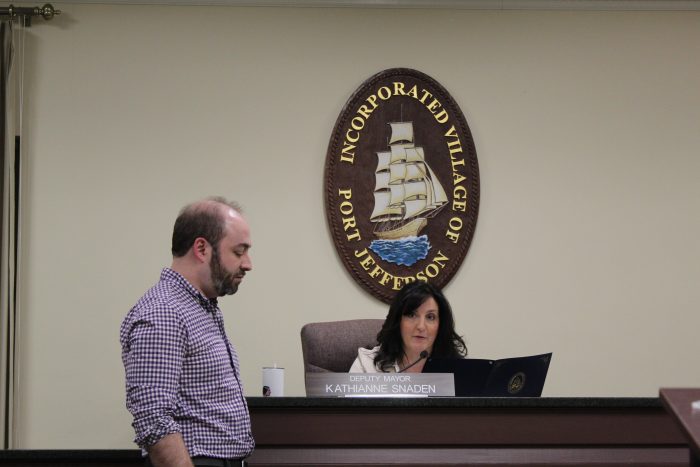Residents deserve better than one-party rule
In the May 4 edition, the editorial board highlights that the Brookhaven landfill is a major issue in this year’s Town of Brookhaven elections [“The landfill election”]. We need bold leadership to tackle Long Island’s decades-long solid waste crisis. This is an issue of economic, environmental and racial justice that we can no longer afford to ignore.
Carting our garbage off of Long Island to another community is not a sustainable solution. We must reduce our waste, and this cannot only rest on individual households, but also on businesses and producers. We can incentivize waste reduction with pay-as-you-throw programs. We can also utilize the knowledge of experts like Stony Brook University’s research associate professor David Tonjes, whose work on waste management provides guidance on how we can address this crisis with innovation and ingenuity. We are capable of long-term, sustainable policy, but only if we have the political and moral courage to do so.
It is clear to me that the current Town Board are not the people to meet this moment. The past decade of one-party rule in Brookhaven includes a botched rollout of the recycling program, our roads in disrepair, and gerrymandering our council districts to bolster a weak incumbent in the 4th Council District. They have left us with a solid waste crisis, used nearly $250,000 of our taxpayer dollars to pay an EPA fine for air quality violations in 2020, and ignored the voices of the directly impacted residents of North Bellport time and again. They do not deserve to be reelected in 2023.
Outgoing Supervisor Ed Romaine [R] must be held accountable for his role in the failures of the Town Board he has led. Romaine is seeking the office of Suffolk county executive, and he must be questioned about the harm he has had a hand in creating in the Town of Brookhaven. We as voters must consider if he is fit to handle higher office, given the mismanagement of our municipal government under his leadership.
We deserve better elected officials than we currently have in our town government. The communities of color who have been disproportionately impacted by the landfill crisis deserve to be listened to by our representatives. There is too much at stake to accept the status quo and small-minded thinking of the current Town Board. It is time for bold solutions that meet the urgency of the moment. It is time for change.
Shoshana Hershkowitz
South Setauket
Still no funding for Port Jeff Branch electrification
Funding to pay for a number of transportation projects and pay increases for transit workers were items missing from Gov. Kathy Hochul’s [D] $229 billion budget.
There is no new funding to advance Hochul’s three favorite NYC transportation projects: the $8 billion Penn Station improvements; $7.7 billion Second Avenue Subway Phase 2; and $5.5 billion Brooklyn-Queens Interborough Express light rail connection. Also missing was funding to advance the $3.6 billion Long Island Rail Road Port Jefferson Branch electrification project. All Port Jefferson LIRR riders have to date is the ongoing LIRR diesel territory electrification feasibility study.
There was no additional funding to pay for upcoming 2023 NYC Transport Workers Union Local 100 contracts for LIRR and Metro-North Railroad employees. The MTA only budgeted for a 2% increase. NYC TWU president, Richard Davis, will ask for far more so his 40,000 members can keep up with inflation. Both LIRR and MNR unions, with thousands of members, will want the same.
Larry Penner
Great Neck
Maryhaven: a breakdown of process
Our village process is broken. Let’s take the Maryhaven project as a recent example of what’s wrong.
This proposed development should have been brought to the Port Jefferson Village Board of Trustees via the Planning Board, which is responsible for overseeing all building-related matters.
But during the recent public hearing, we learned from the developer that he’d been in discussions with the mayor, deputy mayor and village clerk for well over a year, despite the fact there was still no proposal before the Planning Board. The first time the rest of the trustees heard about the project was when it was announced by the deputy mayor at a public meeting on March 6 of this year.
It’s likely the village attorney was also aware of these talks. As previously reported in this paper, he was pressing the village to be “proactive” and change the code to rezone the property in order to clear the path for the developers, whenever they were ready to apply. To that end, he proposed the May 1 public hearing. The attorney also suggested that if the code modification wasn’t suitable to the residents as is, there would be an opportunity to make adjustments. That is not entirely accurate.
We know this from our experience with the Mather Hospital expansion. Before the project came to a public hearing, the village made several decisions, from seemingly irrelevant (at the time) code changes to the most crucial, allowing the hospital a variance for extra clearance. The latter resulted in 2 precious acres of forest being cleared.
The impression the village gave at the time was that residents would still have a chance to weigh in. But when that time came, despite nearly 70 letters protesting the clearing of the forest and all the objections raised at the hearing, it was too late.
The Planning Board’s position was that its hands were tied by all those prior decisions, and it did not have the tools to consider the objections. In other words, we should have been paying attention when Mather first announced the master plan.
So forgive us if we’re skeptical when the village attorney tells us that we’ll have an opportunity to comment on the project overall at a later date.
Ana Hozyainova, President
Holly Fils-Aime, Vice President
Port Jefferson Civic Association
Declining public revenue in Port Jeff
The spirit of New York’s Freedom Of Information Act is transparency and access. Its introduction states, “The people’s right to know the process of governmental decision-making and to review the documents and statistics leading to determinations is basic to our society. Access to such information should not be thwarted by shrouding it with the cloak of secrecy or confidentiality.”
The issue of the future tax revenue from the Port Jefferson Power Station is critically important to both the Village of Port Jefferson and the Port Jefferson School District. So, it is surprising to me that the LIPA settlement agreement is not made available on the village or school district websites. And when I asked the village that a link be included, I was told that the village attorney advised the village not to put it on the website. I would have to complete a FOIL application. I did so. It had no redactions, and nothing in the document contained any confidentiality clause. The Town of Huntington puts its Northport Power Plant LIPA agreement on its website. So what is the objection to making the Port Jefferson agreement accessible to all on our websites? Would they prefer to have the fewest taxpayers know its full terms and potential consequences?
While both the village and school district are quick to tell us how little our tax bills will rise when promoting 30-year bond proposals, their assumptions are highly suspect given the lack of any reasonable assurance that the LIPA benefit will survive beyond the glide path expiration just four years away. Both the Port Jeff and the Northport agreements state that any extensions under the same terms beyond the 2027 expirations are dependent on power needs of National Grid. With repowering off the table, and the state’s goal of 70% renewable energy by 2030, it would seem there is little likelihood of any significant extension beyond expiration. The Port Jefferson Village budget for 2023-24 reveals LIPA taxes covering 36% of property taxes while the school district budget includes LIPA representing 42%.
It’s time for the village and school district to face the elephant in the room and (1) make critical information available on their websites and (2) for any discussion of potential costs to taxpayers, include calculations that consider a potentially abandoned power plant and taxpayers having to face 60%-plus tax increases to make up the LIPA loss.
Robert J. Nicols
Port Jefferson
Time to put the brakes on spending
Port Jefferson and Belle Terre residents are facing a school district budget and bond vote Tuesday, May 16, at the Port Jefferson high school from 6 a.m. until 9 p.m.
It’s a rather hefty price tag being proposed: $47 million for the proposed 2023-24 budget and close to $16 million additional for a bond focused entirely on enhancements to the high school.
While district residents have been more than generous in past years in support of our schools, maybe it’s time to ask if spending over $50,000 each year to educate a student is really feasible. (That’s the amount when you divide the proposed 2023-24 budget by the 933 students in the district, as suggested by Deputy Superintendent Sean Leister as a simple approximation of the per pupil costs, at the village board meeting on May 1.)
Perhaps this is the time to put the brakes on this spending and take a hard look at the future of the high school and consider alternatives.
Charles G. Backfish
Port Jefferson
We need to say ‘no’ to the school bond
Port Jefferson School District residents will be asked May 16 to approve an almost $16 million bond entirely for the benefit of the high school building. The more crucial question to be asked is: “Why are we considering this enormous expenditure when our high school student population is still dwindling?”
According to the school district’s own numbers — found on the district website or online (Long Range Planning Study, Port Jefferson Union Free School District 2021-22) — our enrollment numbers are declining precipitously. On page 18 of the report, our high school’s total enrollment grades 9-12 by 2031 will be a mere 233 students. Divide that number by the four grades in the school and your average graduating class size by 2031 would be only 58 students.
Port Jefferson high school’s small size cannot be compared to that of a prestigious private high school. Even most of the top private schools like Choate, Phillips and Exeter keep their total high school enrollment over 800 students. Most parents want a high school atmosphere that is academically, athletically and socially rich for their children — a true preparation for college. A high school with less than 240 students can’t realistically provide that.
Our high school is presently functioning with the classroom configurations it has had for decades. Before we invest many millions to move art, tech ed and music to the main building to create team and trainer rooms, let’s first focus on what we do if the high school population keeps dwindling, as the district study projects.
Perhaps we could maintain a strong pre-K through 8th grade school system here and investigate tuitioning out our high school students to Three Village and/or Mount Sinai. This solution has been used successfully by many small school districts. Other larger local districts are facing declining enrollments as well, undoubtedly because of the high home prices and high taxes presenting an obstacle to young families seeking to move to this area. Given that reality, neighboring school districts would welcome our high school students.
Right now, we need to say “no” to the school bond. Before we spend almost $16 million on the high school building, we must find a solution to this ongoing decline in enrollment. To keep ignoring this serious issue is unfair to our already stressed-out taxpayers — and equally unfair to our future high school students.
Gail Sternberg
Port Jefferson
Experience matters
Kathianne Snaden is running for mayor and Stan Loucks is running for reelection as a trustee for the Village of Port Jefferson. They have worked together on the village board for four years.
Kathianne has shown to be tireless and dedicated to the betterment of every facet of our village. She has opened the doors to the internal workings of government by live streaming the board meetings, originating the Port eReport and the practice of responding to every and all questions from everyone. As the liaison to the Code Enforcement Bureau, she is totally committed to improving public safety and was responsible for increasing the presence of the Suffolk County Police Department. Kathianne is also our liaison to the Port Jefferson School District. This is an important relationship that was absent and created by Kathianne.
Stan Loucks has been devoting his retirement years to the Village of Port Jefferson. Prior to his election to the village board in 2015, he was on the tennis board, the board of governors, the greens committee and the Port Jefferson Country Club management advisory committee for a total of 20 years, including chair. Stan has been the liaison to the parks and recreation departments, deputy mayor and liaison to the country club.
He is a hands-on person who will always be directly involved in any issue related to his duties. He has been directly responsible for numerous projects and improvements such as renovation of the golf course; building a new maintenance facility, driving range, fitness center, membership office; upgrading village parks; initiating relationships with our schools and much more.
Kathianne was TBR News Media Person of the Year in 2019, and Stan was Person of the Year in 2021. Seems like they would be the team that we would want to represent our village.
Experience, knowledge, integrity, dedication and hard working are qualities that we need.
Jim White
Port Jefferson
Editor’s note: The writer is a former Port Jefferson Village trustee.
WRITE TO US … AND KEEP IT LOCAL
We welcome your letters, especially those responding to our local coverage, replying to other letter writers’ comments and speaking mainly to local themes. Letters should be no longer than 400 words and may be edited for length, libel, style, good taste and uncivil language. They will also be published on our website. We do not publish anonymous letters. Please include an address and phone number for confirmation.
Email letters to: [email protected]
or mail them to TBR News Media, P.O. Box 707, Setauket, NY 11733


















